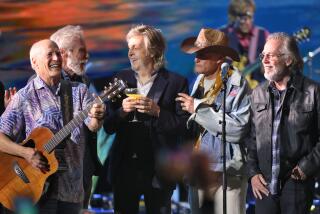BOOK REVIEW : Learning at the Knee of Your Average Self-Made Billionaire : BUFFETT: The Making of an American Capitalist <i> by Roger Lowenstein</i> ; Random House $27.50, 473 pages
- Share via
Ross Perot, like Carnegie and Rockefeller and Ford before him, reminds us that wealth inspires an almost mystical reverence in American culture. Those who know how to make and keep millions of dollars must possess some arcane and powerful secrets; why else are they so rich?
So we come to “Buffett,” Roger Lowenstein’s biography of Omaha billionaire Warren Buffett, with some of the same lofty expectations that have long attracted a cult-like following to study at his feet.
“Once a year, disciples and money men would flock to Omaha like pilgrims on a hajj, to hear Buffett deconstruct the intricacies of investing, business and finance,” writes Lowenstein, a reporter for the Wall Street Journal. “Financial groupies arrived in Omaha clutching Buffett’s writings like a Bible and reciting his aphorisms like excerpts from the Sermon on the Mount.”
What they found in Omaha--and what we find in “Buffett”--is a self-effacing and seemingly ordinary man who looks (and lives) more like a slightly eccentric basement inventor than a stock-market mogul. Significantly, Lowenstein compares Buffett not to the plutocrats who preceded him but to an entirely different line of “self-made men”--Abraham Lincoln, Mark Twain, Will Rogers.
Lowenstein tries to invest the mostly unremarkable facts of Buffett’s childhood and adolescence with pre-figurings of his financial genius. Buffett’s very first possession, we are told, was “a nickel-plated money changer.” Inevitably, he ran a sidewalk lemonade stand and had a newspaper route. His first stock speculation came at the age of 11, and his favorite book was “One Thousand Ways to Make $1,000.”
By the time he showed up at the Wharton School at the age of 17, he was already convinced that he knew more than the so-called experts about how to make money. “All I need to do is open the book the night before,” he boasted, “and drink a big bottle of Pepsi-Cola and I’ll make 100.”
Indeed, Buffett had amassed nearly $10,000 from his adolescent enterprises by the time he finished college, and--as Lowenstein explains--”that trifling grubstake would be the source of every dollar that Buffett would earn.”
Lowenstein has set himself the task of searching out the secret of Buffett’s success--”the Zen of Warren Buffett”--but he comes no closer than the revelation that Buffett studied under Ben Graham, a Columbia professor who served as Buffett’s grad-school guru and provided the young Buffett with “the first reliable map to that wondrous and often forbidden city, the stock market.”
Graham’s investment philosophy, which Buffett would embrace and elaborate upon, was simple enough: “Look for companies that were so cheap as to be free of risk.” Lowenstein goes into considerably more detail in chronicling how Buffett applied this simple principle in the stock market and the boardroom over the last 40 years, but Buffett has always explained himself and his stock picks with the same kind of cracker barrel rhetoric.
“If I can’t understand something,” Buffett once wrote to his investors in one of his famous letters, “I tend to forget it.”
Lowenstein has accomplished something remarkable in “Buffett”: The author has taken a mild-mannered and mostly lackluster man whose only real accomplishment is making money and managed to make him come almost alive, to evoke something of the flesh and blood behind the statistics, even if Buffett is shown to be rather tight with his billions when it comes to philanthropy and his own creature comforts.
“What he does,” says columnist Ann Landers of her friend, “is piling and heaping and heaping and piling.”
So Lowenstein can never really escape the fact that money is what really matters to Buffett. Lowenstein tells the story, for instance, of Buffett’s visit to William Randolph Hearst’s art-filled mansion at San Simeon--and he reveals that Buffett was “bored to tears” by the tour.
“Don’t tell us how he spent it,” Buffett complained to the tour guide. “Tell us how he made it!” I suspect that exactly the same thing will be said by the likely readership of Lowenstein’s biography--and they will not be disappointed. While he comes up with some halfhearted explanations for what drives Buffett--an unstable mother, an autocratic father, the fear of death--Lowenstein himself is clearly much more interested in how those billions of dollars were actually made.
Notably, Lowenstein’s book begins not with an epigram but with a chart--a graphic comparison of the performance of the Dow Jones Industrial Average with Buffett’s Berkshire Hathaway Inc. between 1965 and 1995. The Dow Jones sputters along the bottom of the chart; Buffett’s portfolio shoots almost straight up.
For many readers of “Buffett,” I imagine, that’s all they really need to know.
More to Read
Sign up for our Book Club newsletter
Get the latest news, events and more from the Los Angeles Times Book Club, and help us get L.A. reading and talking.
You may occasionally receive promotional content from the Los Angeles Times.







